 |
|
 |
|
updated to follow: Stratigraphic Guide to the Rogaland Group, Norwegian North Sea. Harald Brunstad, Felix M. Gradstein, Jan Erik Lie, Øyvind Hammer, Dirk Munsterman, Gabi Ogg, and Michelle Hollerbach. Newsletter on Stratigraphy, vol 46/2 pp137-286, 2013.
Heimdal Member | Mey Member | Siri Member |Sotra Member |
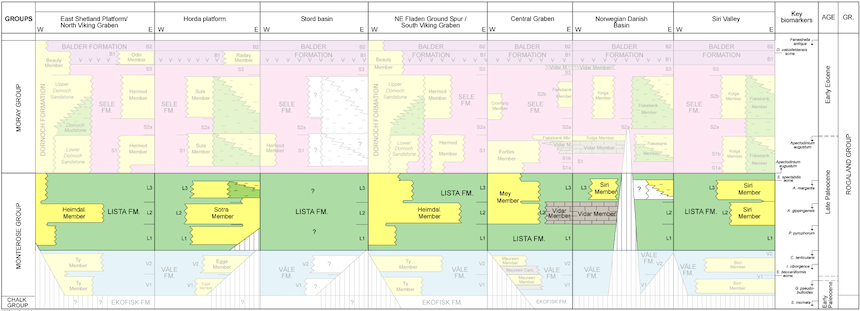
Fig. 65. Lithostratigraphic summary chart of the Lista Formation (color) with members. |
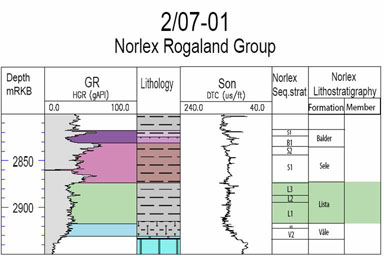
Fig. 66. Well 2/7-1. Composite log Rogaland Group. Stratigraphic position of the Lista Formation is outlined in the stratigraphic column to the right. |
Norwegian well 16/8-1 (Fig. 68). Depth 1749 to 1708 m. Coordinates N 58°27'24.80", E 02°25'56.80". No cores. Defined by Hardt et al. (1989).
Norwegian well 9/11-1 (New, Fig. 69). Depth 1483-1592 m RKB. Coordinates N 57°00'41.40", E 04°31'40.60. No cores.
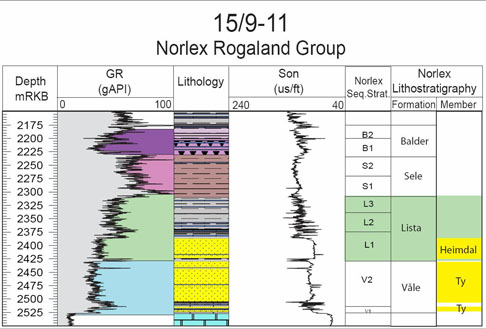
Fig. 67. Well 15/9-11 composite log Rogaland Group. Stratigraphic position of the Lista Formation is outlined in stratigraphic column to the right. |
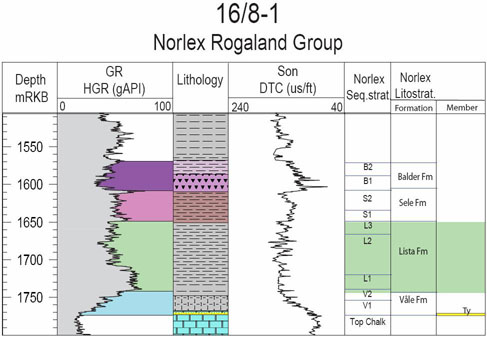
Fig. 68. 16/8-1 composite log Rogaland Group. Stratigraphic position of the Lista Formation is outlined in stratigraphic column to the right. |
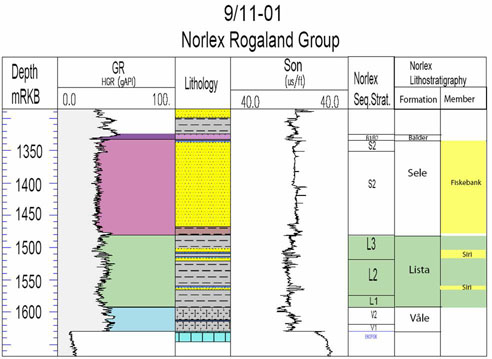
Fig. 69. 9/11-1 composite log Rogaland Group. Stratigraphic position of the Lista Formation is outlined in stratigraphic column to the right. |
Representative core photo examples of mudstones of the Lista Formation are shown in Fig. 70.
The examples show mudstones of dominantly green grey colour, and with purple red patches. As can be seen the mudstones have a mottled and poorly laminated look, which can be explained by heavy bioturbation. Zoophycos (Fig. 70), Chondrites and Planolites are common trace fossils in the Lista Formation.
The shales of the Lista Formation are generally characterized by intermediate wire line log readings, but there is considerable variability, and several internal zones with high gamma-ray readings occur, representing flooding or condensation surfaces. Velocity logs display spikes of high acoustic velocity that can be related to thin beds or nodules of carbonate.
The top of the Lista Formation is commonly associated with a well expressed, extensive seismic event, where the higher velocity Lista Formation is underlying a low velocity zone in the lowermost part of the Sele Formation, and thus giving a positive acoustic impedance contrast.
When sandstones are present in the Lista Formation this is often associated with thickening as well as semi-continuous, undulating internal reflectors and lense shapes, mounds and trough infills.
The body of the Lista Formation contains the last occurrence (tops) of the following agglutinated taxa in the shown (most likely) stratigraphic order:
The Lista Formation belongs in the foraminiferal Zone NSR2A - 2B, A. ruthvenmurray - R. pauperum (Gradstein & Bдckstrцm, 1996), and the dinocyst Zones D3b - D4 in Luterbacher et al. (2004). The age is Late Selandian through Thanetian, late Middle through Late Paleocene.
Some diagnostic microfossils of the Lista Formation are shown in Fig. 71.
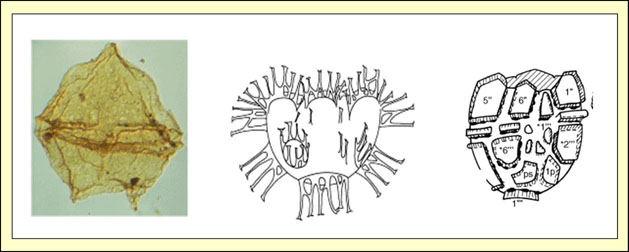
Fig. 71. Some diagnostic microfossils of the Lista Formation. Palaeoperidinium pyrophorum (Ehrenberg 1838 ex O. Wetzel 1933a) Sarjeant 1967b. Dorsal view of dorsal surface; 450x. Areoligera gippingensis Jolley 1992. Ventral view. Range of type material: overall length = 32-42 µm, overall width = 45-59 µm, process length = 15-33 µm. Alisocysta margarita (Harland 1979a) Harland 1979a. Ventral view. Holotype dimensions: length = 44 µm, width = 40 µm. From the ODP Drilling Program at http://www-odp.tamu.edu. |
The base of the L1 zone is picked at the high gamma shale that occurs between the I. ?viborgense and T. cf. delicata dinocyst zones and close to the top of the Cenosphaera lenticularis microfaunal zone. The boundary between the L1 and L2 is taken at the high gamma shales associated with the P. pyrophorum acme, and the boundary between L2 and L3 is taken at a high gamma zone associated with the A. gippingensis acme. The top of the L3 zone is taken at the high gamma peak near the base of the Sele Formation, which is associated with the top of impoverished agglutinated assemblage.
Internally in the Lista Formation several sandstones members are found (Figs. 72). The Siri Member and Sotra Member seem to have an eastern provenance (Scandinavia), whereas the Mey Member and the Heimdal Member have a western provenance (Shetland Platform).
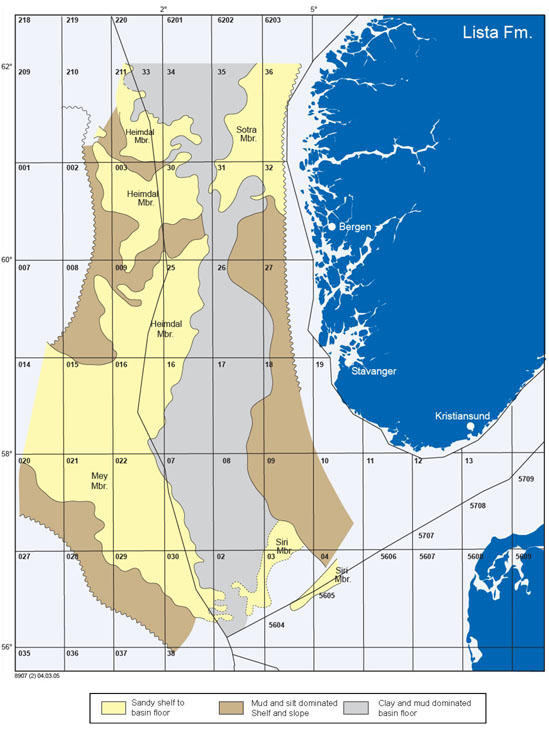
Fig. 72. Distribution of the Lista Formation and its sandstone Members. |
The Lista Formation was deposited in a marine environment where the earlier calcareous input from microorganisms, and reworking from exposed chalk of the Shetland Group had come to an end. Accordingly the fines deposited in the basin were dominated by siliciclastic minerals. The trace fossils in the sediments in general became smaller and sediments darker, reflecting a less well oxygenated basin in this period.
In the basinal areas of the Viking Graben, Stord Basin and the Central Graben paleo
waterdepth was mostly deep marine, bathyal. To the east paleo waterdepth was shallower,
extending into upper continental shelf slope or shelf setting. Changes between faint dark
purple red and medium grey to dark green colored bioturbated mudstones probably reflect
changes in the balance between water circulation and sedimentation rate. The change between
rich and abundant bioturbation in the mudstones reflects change from rather oxygen rich and
well circulated bottom waters to dysoxic or sometimes anoxic conditions. The silty fraction
increases towards the slope wedges flanking the basin to the east and west (UK).
| home | previous page |